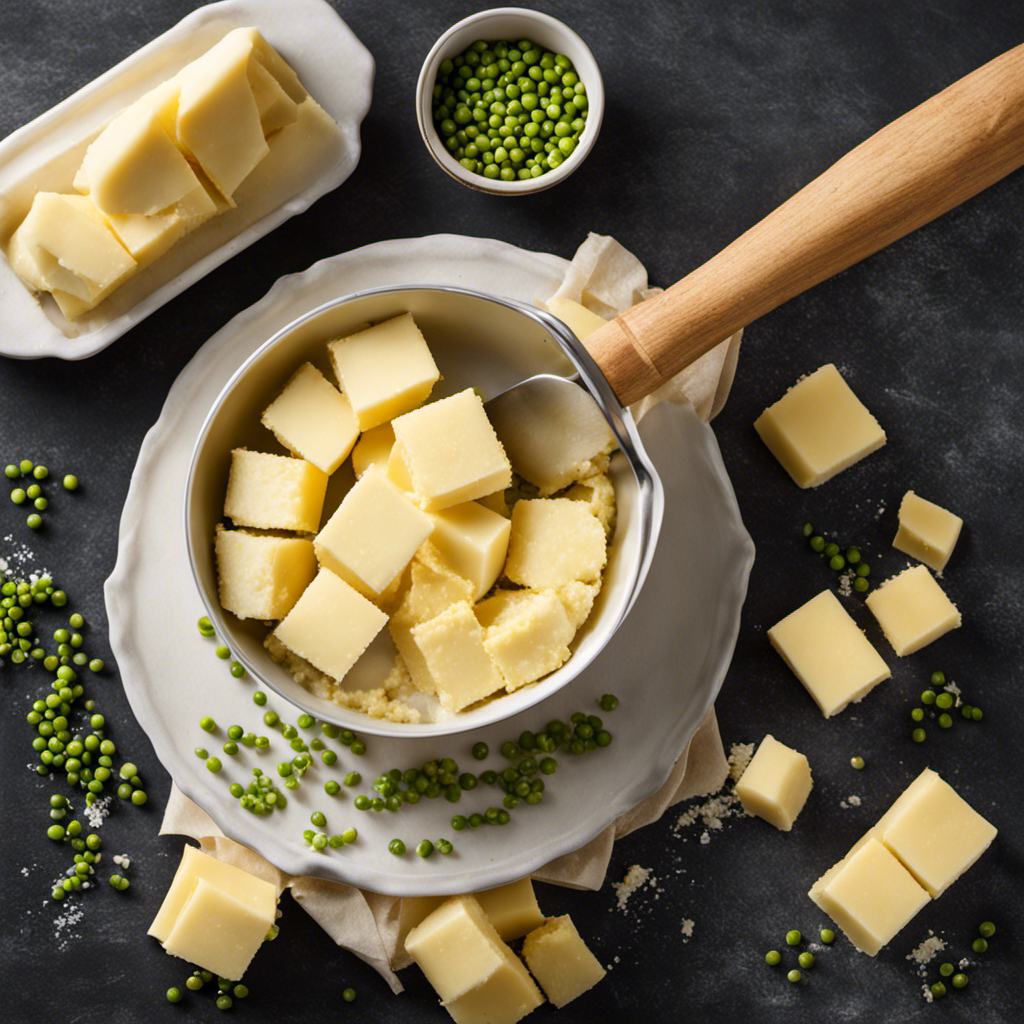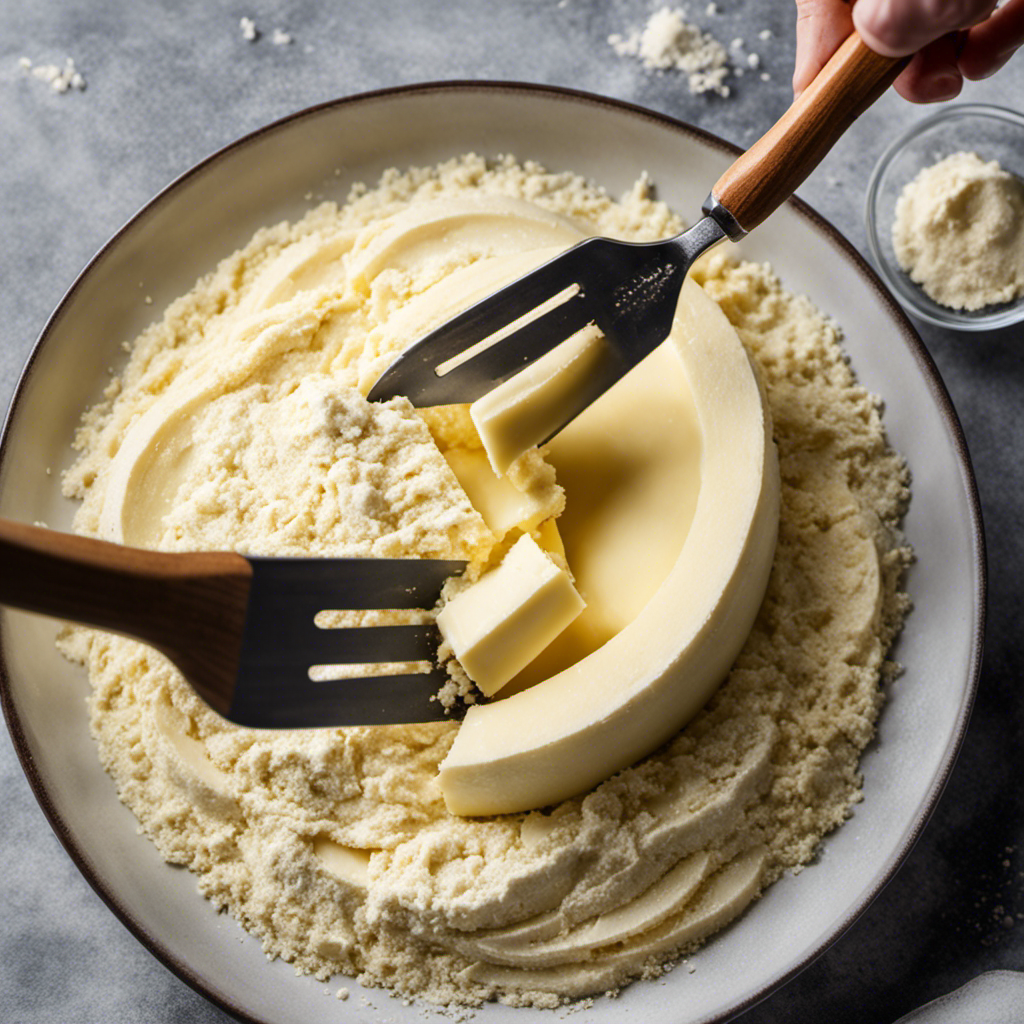To avoid pitfalls with stock versus broth, choose the right liquid for your recipe—homemade offers fresh, adjustable flavor, while store-bought can contain preservatives. Never over- or under-season; taste as you go and maintain proper simmering time for clarity and flavor extraction. Always strain or clarify for a smooth texture, and store your stock or broth properly to prevent spoilage. Keep these tips in mind, and you’ll master your culinary liquids with confidence.
Key Takeaways
- Clearly distinguish between stock and broth to select the right base for your recipe.
- Use homemade liquids for richer flavor or choose store-bought options carefully.
- Properly season and taste during cooking to avoid over- or under-seasoning.
- Maintain gentle simmering times for clarity and optimal flavor extraction.
- Strain and clarify broth or stock for better texture, appearance, and taste.
Using the Wrong Type of Liquid for Your Recipe

Choosing the wrong liquid can substantially alter the flavor and outcome of your dish. When deciding between homemade and store-bought options, consider how each impacts your recipe’s depth and richness. Homemade liquids often have a fresher, more complex flavor, allowing you to tailor ingredients to your taste. Store-bought broths and stocks are convenient and consistent but may contain preservatives that affect flavor. Adjusting flavor profiles becomes essential when selecting your liquid. If you choose a store-bought option, you might need to enhance it with herbs, spices, or seasoning to match your desired taste. Conversely, homemade liquids give you control from the start, reducing the need for adjustments later. Picking the right type of liquid ensures your dish develops the intended flavor, elevating your cooking results. Additionally, understanding the differences between stock and broth can help you make more informed choices to suit your specific culinary needs especially when preparing seafood dishes.
Over- or Under-Seasoning During Preparation
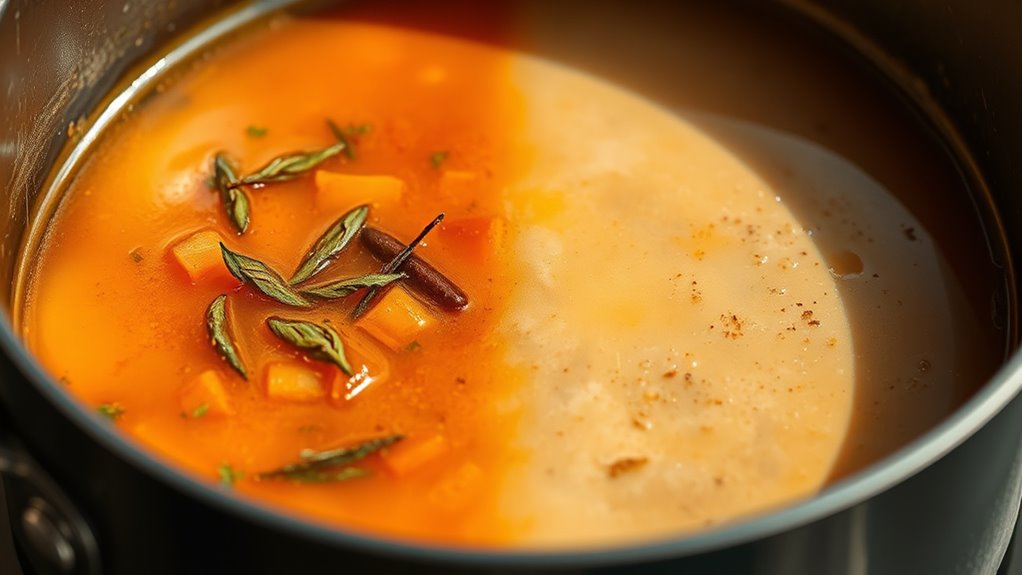
Seasoning your dish carefully during preparation can make or break its final flavor. Achieving the right seasoning balance is essential, so taste as you go and avoid over-seasoning. Too much salt or spices can overpower the subtle flavors of your stock or broth, while too little leaves it flat and unappetizing. Focus on ingredient pairing—consider how each component complements the others—and adjust seasonings gradually. Remember, flavors develop as they simmer, so start with a conservative amount and add more if needed. Keep in mind that seasoning is a personal preference, but restraint guarantees your dish remains balanced and nuanced. Proper seasoning during preparation sets the foundation for a delicious final dish. Additionally, understanding how techniques like somatic therapy can help manage stress may improve your overall cooking experience by promoting calm and focus.
Ignoring Proper Simmering Times and Techniques
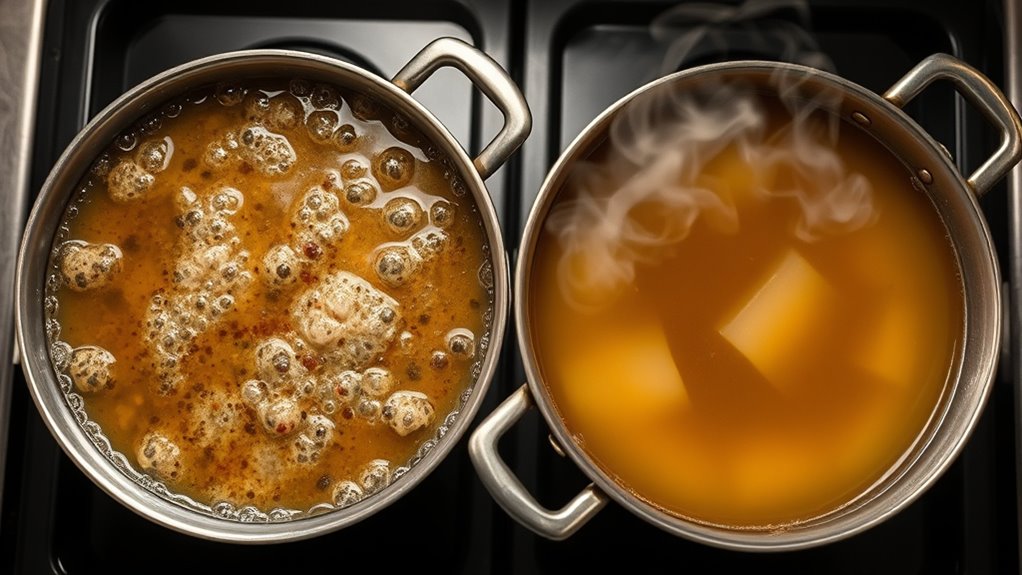
Ignoring proper simmering times and techniques can substantially undermine the flavor and clarity of your stock or broth. If you don’t pay attention to simmering duration, you risk overcooking or undercooking ingredients, which affects taste and texture. Too long, and flavors can become bitter or muddled; too short, and the broth may lack depth. Technique precision is essential—maintaining a gentle, steady simmer prevents cloudiness and preserves clarity. Keep the heat low enough to avoid boiling vigorously, which agitates particles and produces a cloudy result. Monitoring simmering duration and adjusting heat accordingly ensures you extract ideal flavors without compromising clarity. Additionally, understanding the importance of a consistent contrast ratio can help you achieve a clearer, more vibrant broth by controlling how light and dark elements are represented visually. Mastering these details helps you achieve a flavorful, clean broth or stock that elevates your dishes.
Neglecting to Strain or Clarify for Better Texture and Clarity

Neglecting to strain or clarify your stock or broth can leave unwanted solids, fats, and impurities floating or settled at the bottom, which negatively impacts both texture and appearance. Proper straining techniques and clarification methods guarantee a smooth, clear, and refined result. To improve your stock’s quality, consider these steps:
- Use a fine-mesh sieve or cheesecloth to remove solids after cooking.
- Employ clarification techniques, such as egg white clarification, to trap impurities and achieve clarity.
- Reheat and strain the broth again if needed, removing any residual fats or particles for a cleaner finish.
- Understanding resources and tools available can help you select the best equipment for achieving a perfectly clear broth.
Failing to Store and Use Stock or Broth Before It Spoils
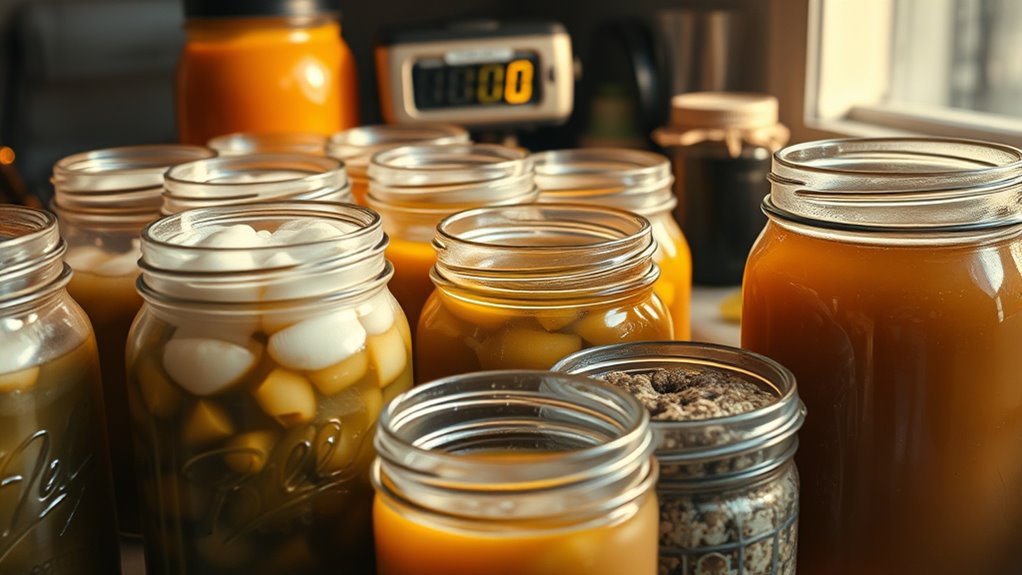
If you don’t store your stock or broth properly, it can spoil quickly and pose health risks. Common storage mistakes, like leaving it out at room temperature or not using airtight containers, increase spoilage chances. To prevent this, always cool your stock promptly and refrigerate it within two hours of cooking. Use shallow containers to speed up cooling, and label them with dates to track freshness. Freezing excess stock extends its shelf life and reduces waste. Remember, spoiled broth may develop off odors, mold, or change in appearance—discard it immediately. Proper spoilage prevention guarantees your stock remains safe and flavorful for future use. Ensuring proper food safety practices is essential to prevent contamination and health hazards. Taking these simple steps helps you avoid health hazards and maximizes the value of your homemade or store-bought broth.
Frequently Asked Questions
How Can I Tell if My Stock or Broth Has Gone Bad?
You can tell if your stock or broth has gone bad by checking freshness indicators like sour or off smells, which signal spoilage. Look for storage signs such as a slimy texture or discoloration on the surface. If it tastes sour or has bubbles that weren’t there before, it’s best to discard it. Always trust your senses and store your stock or broth properly to maintain freshness longer.
What Are the Best Containers for Storing Homemade Stock or Broth?
You should store your homemade stock or broth in airtight containers to prevent spoilage and contamination. Opt for freezer-safe options, such as sturdy plastic or glass containers labeled for freezer use, to avoid cracks or leaks. Leave some space at the top for expansion during freezing. Properly stored, your stock or broth stays fresh longer, maintains flavor, and reduces waste. Always label with date before freezing for easy tracking.
Can I Substitute Water for Stock or Broth in Recipes?
Using water instead of stock or broth in recipes is possible but not recommended, as it’s like trying to cook a masterpiece without color or flavor. Water won’t provide the rich flavor enhancement you get from stock or broth, and it’s a poor ingredient substitution. If you want depth, try adding herbs, spices, or even a splash of soy sauce instead, to boost the dish’s flavor profile.
How Do I Adjust Seasoning Without Overcompensating?
To adjust seasoning without overcompensating, start by adding small amounts gradually and tasting as you go. Focus on maintaining a balance in seasoning, so no single flavor overwhelms the dish. Use flavor enhancement techniques like a splash of acid or a pinch of salt to subtly boost flavors without overdoing it. This careful approach helps you achieve the perfect seasoning balance while enhancing the overall flavor.
What Are Common Mistakes to Avoid During the Simmering Process?
Imagine your pot boiling over like a volcano—that’s a mistake to avoid! During simmering, don’t overuse ingredients, which can overpower the flavor, or simmer for too long, turning your broth into a flavorless mush. Keep the heat gentle, monitor the simmering duration carefully, and taste often. This way, you’ll prevent ingredient overuse and guarantee your broth develops rich, balanced flavors without turning into a culinary catastrophe.
Conclusion
By avoiding these pitfalls, you’ll turn your stock or broth into a golden, aromatic foundation that elevates every dish. Imagine ladling a steaming bowl, the rich aroma swirling in the air, clear and inviting. When you choose the right liquid, season thoughtfully, and handle it with care, your kitchen transforms into a cozy sanctuary of flavor. Keep these tips in mind, and you’ll always serve up warmth and comfort in every spoonful.




